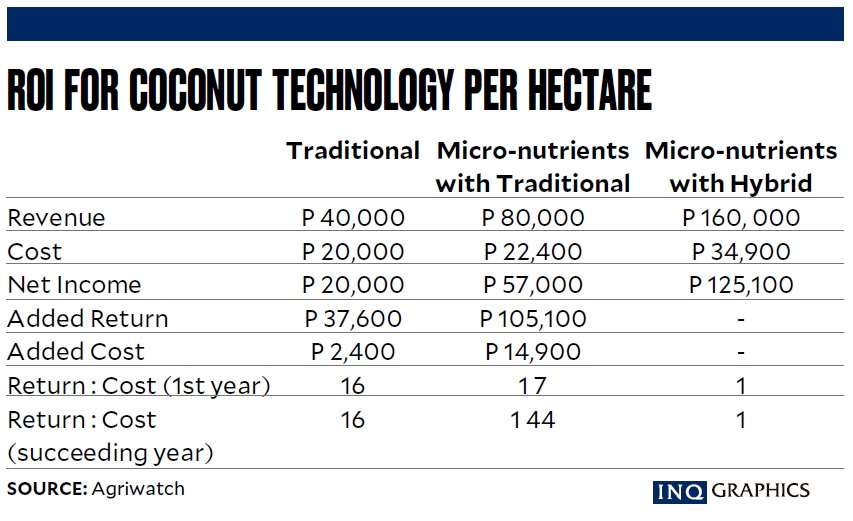ROI approach needed for agriculture
If we used the return on investment (ROI) approach for agriculture, it would accelerate agriculture development. This became obvious when I participated in the one-day technology session conducted by Ramon Rivera (0917-722-8049) on Octo. 14.
Rivera, head of Philippine Coconut Authority (PCA) Zamboanga Research Center, showed how technology could significantly help coconut farmers overcome poverty. More importantly, he showed how technologies with different ROIs resulted in differential benefits for the farmers.
In the traditional column where little technology was used, a farmer earned an average annual net income per hectare of only P20,000. By adding only P2,400 for micronutrients, the farmer realized a net income of P57,600. With the added use of hybrid technology where a one-time investment of P2,500 is needed for the next 60 years, the net income rises to P125,100.
The following analysis was what opened the participants’ eyes to the ROI approach. When we compare the added return to the added costs, every added peso spent on micronutrients yielded P16. If we further add hybrid seeds, this results in P7 for every extra peso spent during the first year. But for the succeeding 59 years, since there will be no need to plant hybrid seeds again, the return is P44 for every peso spent.
Rivera says both the government and the private sector are not investing in these technologies because they have been kept in the dark of their high ROIs.
For example, in the case of rice, there are yield estimates coming from different technologies.
Pablito Villegas, a current leader in the Philippine Chamber of Agriculture and Food, Inc. (PCAFI), one of the five coalitions in the Agri-Fisheries Alliance (AFA), gave the following yield estimates for the different seed technologies: 3 tons for traditional, 4 tons for certified and 7 tons for hybrid seeds.
Article continues after this advertisementAssuming an average 3.5 tons per hectare for only one annual cropping in non-irrigated areas, providing irrigation would double the yield to 7 tons. This is because of an additional harvest season made possible through the available irrigation water. Building this irrigation system costs P300,000 to P700,000 per hectare.
Enter the ROI approach. To double the yield in a year for non-irrigated lands, P500,000 in irrigation infrastructure expense per hectare is recommended. However, if hybrids can double the yield from 3.5 tons to 7 tons per hectare, the hybrid solution of only P7,100 (P5,100 for seeds plus P2,000 for added fertilizer) per hectare is a cheaper solution.
The ROI approach can also be used in choosing which type of irrigation should get the biggest budget allocation.
Sonny Sioson, an Alyansa Agrikultura leader heading several Bulacan farmer cooperatives, says political and possible corruption considerations are taking precedence over ROI. He laments that many Small Water Impounding Projects (SWIPs) had deteriorated and had been abandoned.
With relatively little money for repair, these SWIPs can be fully rehabilitated. Instead, he sees government wasting much money on new large irrigation projects.
It is therefore only with a conscious ROI-mentality on the part of both the government and the private sector that scarce resources can be used optimally, and true agriculture development can take place.
